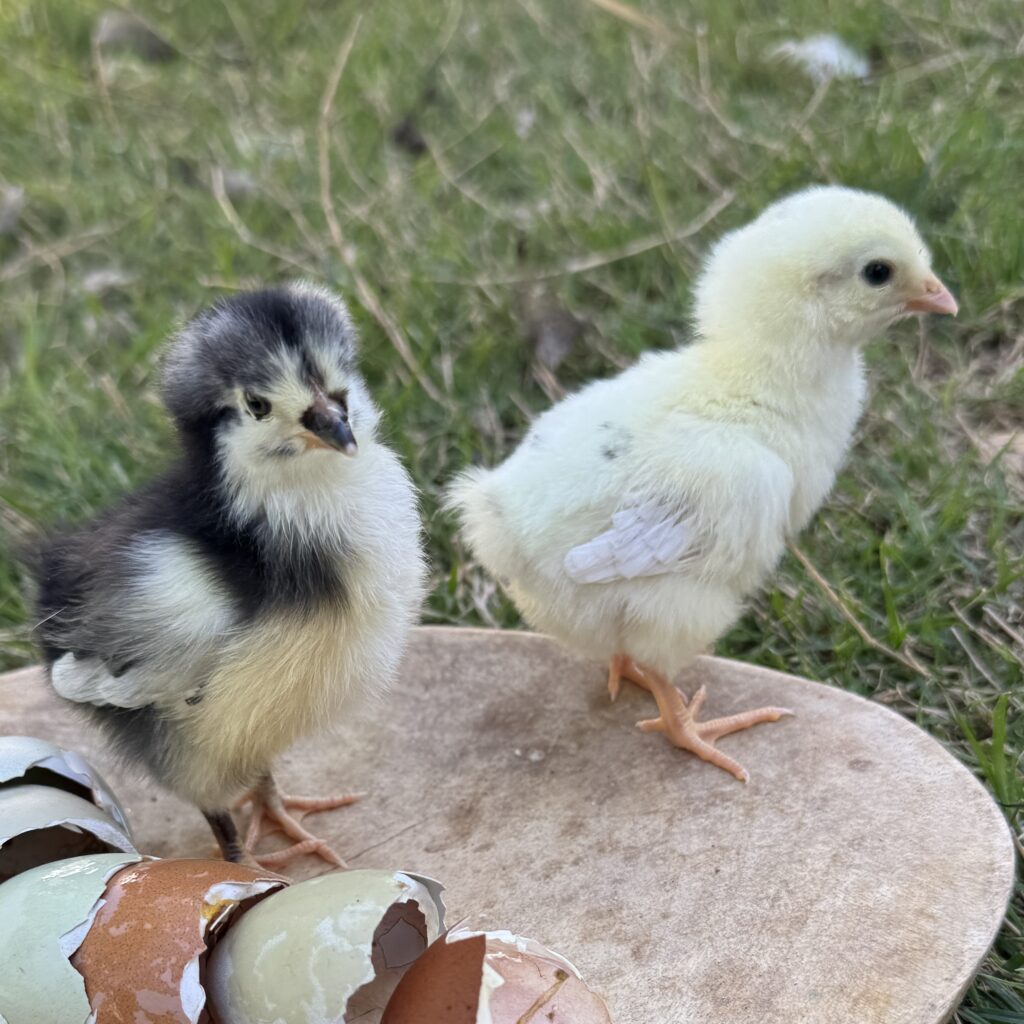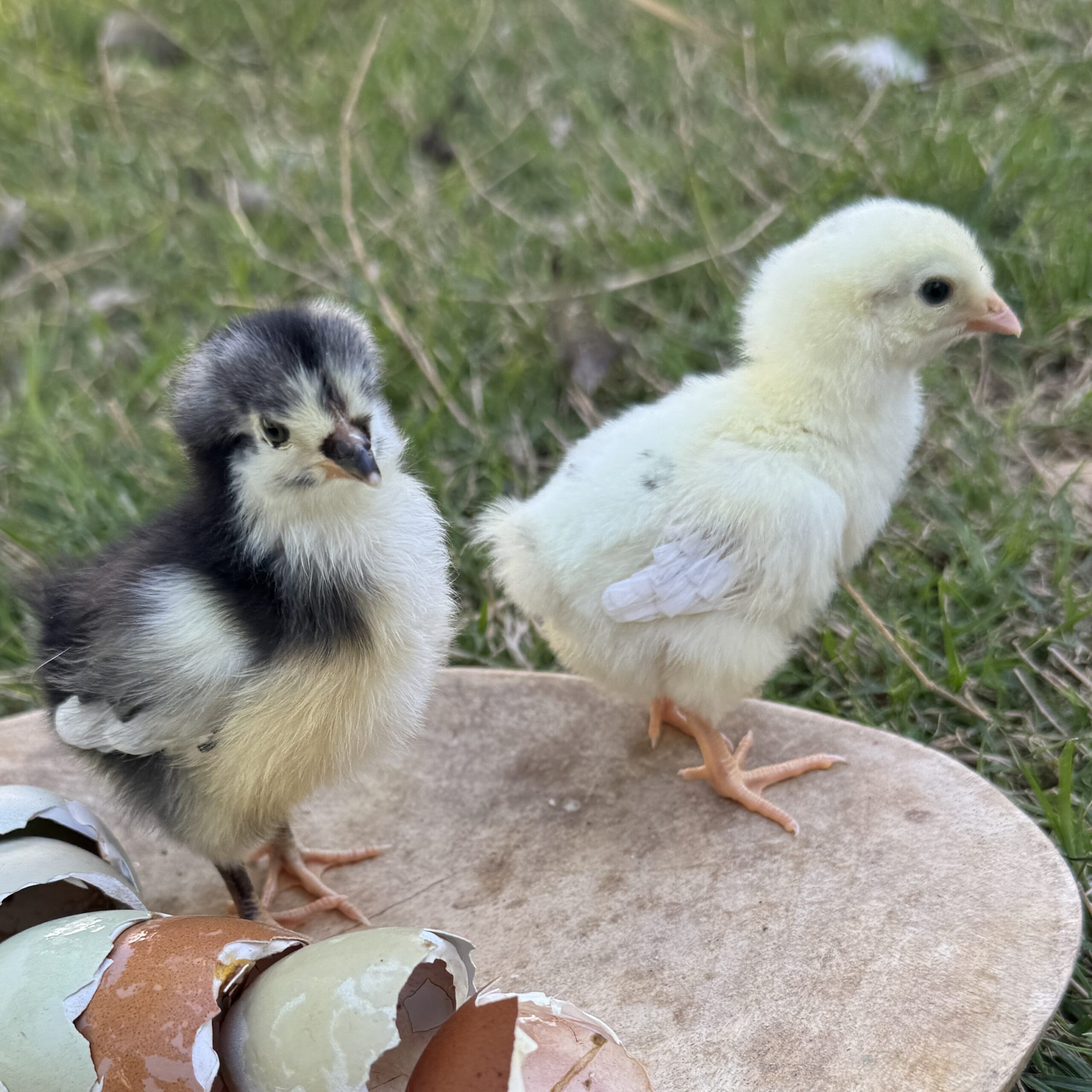🐥 Welcome to New Chick Parenthood!
Your Fun & Friendly Guide to New Chick Parenthood & Raising Baby Chicks
So you’ve just hatched (or brought home) some adorable little peepers—congrats! 🎉 These tiny fluff nuggets are full of personality and potential, and with a little TLC, they’ll grow into clucky companions in no time. Here’s how to give them the best start in life!

🏡 The Brooder: Chick Central
Think of this as their cozy nursery. You’ll need:
- Container: A large plastic bin, cardboard box, or stock tank
- Bedding: Pine shavings (no cedar—too strong!), paper towels for the first few days
- Space: About ½ square foot per chick to start, and more as they grow
Pro Tip: Keep it clean! Change bedding often to avoid stink and sickness.
🌡️ Heat It Up, Baby!
Chicks can’t regulate their body temp, so you’re their sun now 🌞
- Use a heat lamp or brooder plate (safely secured!)
- Temp Guide:
- Week 1: 95°F (35°C)
- Drop 5°F each week until fully feathered (around week 5–6)
Watch their behavior:
🐥 Huddled = too cold | 🐥 Panting/spread out = too hot | 🐥 Evenly spaced = just right
🥣 Feeding Time!
- Starter Feed: Buy chick starter crumble (medicated optional if not vaccinated for coccidiosis)
- Fresh Water: Always available, changed daily
- Add small pebbles or marbles to prevent accidental drowning
Bonus: Toss in a tiny sprinkle of chick grit if you give treats (after week 1)
💩 Health & Hygiene
- Keep everything clean and dry
- Watch for “pasty butt” (poop stuck on the vent)—gently clean with warm water and a soft cloth
- Look for bright eyes, active behavior, and happy peeping!
🐔 Social Life & Handling
- Talk to them gently, handle with clean hands
- Short handling sessions at first = trust building
- Chickens are social—never raise just one chick!
Fun Idea: Give them safe toys or a mini perch to practice roosting!
🗓️ The Chick Timeline (So You Know What to Expect)
| Age | Whats Happening | What to Do | Heat |
|---|---|---|---|
| Week 1-2 | Fluffy & sleepy | Warmth, calm space | 95° |
| Week 2–3 | Curious explorers | Introduce short handling | 85° |
| Week 3-4 | Feathers coming in | Lower brooder temp | 80° |
| Week 5–6 | Almost grown! | Think about coop time | 75° |
| Week 6+ | Fully feathered | Ready to move outside (weather permitting) | good to go! |
🐣 Final New Chick Parenthood Tips
- Chicks are fragile but surprisingly tough—watch, learn, and enjoy the journey
- Always have a backup heat source (power outages = chick emergencies!)
- Chick raising is addictive… don’t say we didn’t warn you 😉
Help what do I do! New Chick Parenthood Edition
WHY ARE MY CHICKS DYING?
While it is not possible for us to know for certain, here are a few things to check:
Temperature: Check that the temperature is not too hot/cold and is it being adjusted appropriately for their age. The warm area should be 95-99°F for the first day or two after arrival, 95°F for the first week and then lowered 5°F each week following until heat is no longer required. Do not heat the entire brooder, they need to have an area to get away from the heat. Comfortable chicks will move in and out of the warm zone to regulate their temperature. If you are using a bulb heater, it should be ceramic or red to not disrupt their natural sleep pattern.
Feed:
Are they on high quality medicated feed? A well-balanced starter feed is important for growing chicks to develop their immune system. We do not vaccinate for coccidiosis, so we strongly recommend using a medicated feed. Be sure the feeder is kept clean and dry.
Water:
Their waterer needs to be kept clean and full of fresh water. You may want to consider adding electrolytes or apple cider vinegar on arrival.
Brooder:
Make sure the chick’s living conditions are kept clean and dry. A dirty, wet, warm environment is prime living conditions for coccidia. Be sure that the brooder is well ventilated and free from draft.
WHAT SUPPLIES DO I NEED TO HAVE READY BEFORE MY CHICKS ARRIVE?
Basic supplies include: a brooder, proper bedding for your brooder (do not use newspaper, magazines, or cedar shavings), heater, thermometer, waterer, feeder, medicated chick feed, and electrolytes or apple cider vinegar (in case your chicks arrive lethargic or stressed). Some great options for bedding are paper towels or pine shavings, that is if you don’t have a wire-bottomed brooder.
WHAT FEED SHOULD I GET FOR MY CHICKS?
We recommend a high-quality medicated chick crumble. Follow the feeding guidelines on the product label. We do not offer a vaccination for coccidiosis, so it is strongly recommended that you start your chicks on a medicated feed.

